John Bewick's Woodcut Illustrations of a Hermit
Children's literature in England, especially in the late 18th and early 19th centuries, included chap books and so-called "toy" books. These books were often written anonymously and were always illustrated.
Banbury blocks, or the engraved woodcuts often illustrating these works, were named after the Oxfordshire town of Banbury, but were produced in several places. Among the titles so illustrated and mentioned by Edwin Pearson in his Banbury Chap Books and Nursery Toy Book Literature of the 18th and Early 19 Centuries (published in 1871) is a little book about a hermit, illustrated by John Bewick (1760-1795).
The book is a version of the true story about the marooned sailor Phillip Quarll told by Edward Dorrington, which inspired Daniel Defoe to write Robinson Crusoe. Pearson calls the children's version "quaint." The full title of the book is The Hermit, or Adventures of Edward Dorrington. Sometimes it was popularly called Philip Quarll. A reprint during Pearson's time was titled Surprising Adventures of Philip Quarll.
The earliest edition identified by Pearson, printed in 1727, has the title:
The Hermit, or the unparalleled sufferings and surprising adventures of Mr. Philip Quarll, an Englishman who was lately discovered by Mr. Dorrington, a Bristol merchant, upon an uninhabited island in the South Sea, where he lived above fifty years without any human assistance, still continues to reside, and will not come away, etc.
The emphasis in the title, especially for a juvenile audience, is on the novelty of a hermit. The title page continues:
He was born in St. Giles', left his master a locksmith, went to sea, married a famous w---e, listed for a soldier, married three wives, condemned at the Old Bailey, pardoned by King Charles II., turned merchant, and was shipwrecked on a desolate island on the coast of Mexico, etc.
Here are some of John Bewick's woodcuts for The Hermit (descriptors added):
 |
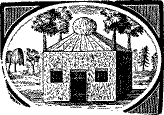 |
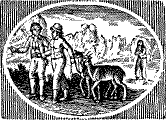 |
| the hermit | the hermit's hut | the goat that fed the hermit |
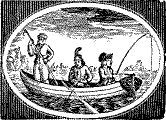 |
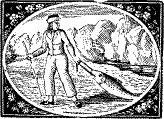 |
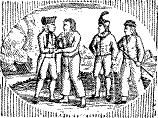 |
|
searching for the hermit |
fishing (?) |
the hermit rescued |
John Bewick was the younger brother of Thomas Bewick, both engravers. The older brother worked with real-life subjects such as mammals, birds, and natural settings. John Bewick illustrated a version of Holbein's "Dance of Death" and a number of children's works before his early death. They changed the character of illustrating for children with their emphasis on simplicity, naturalism, a naive romanticism, and an aura of story-telling.
¶